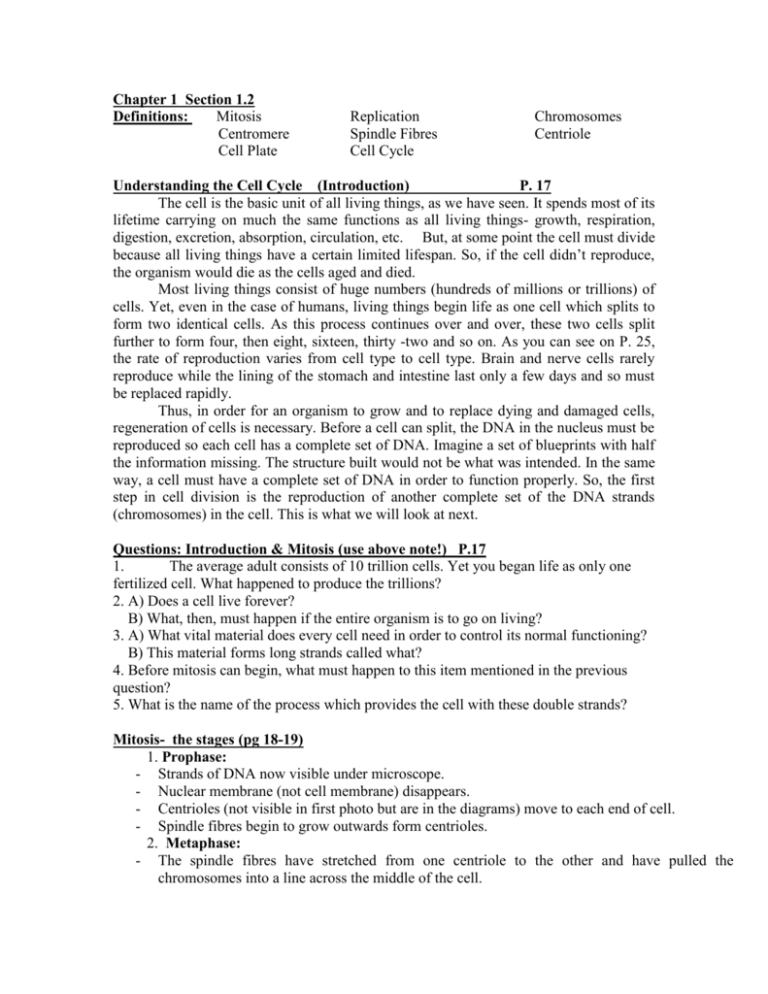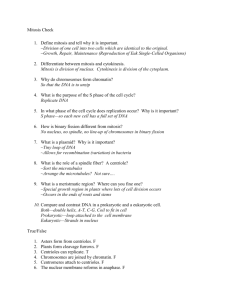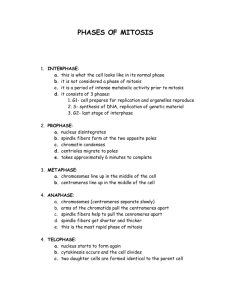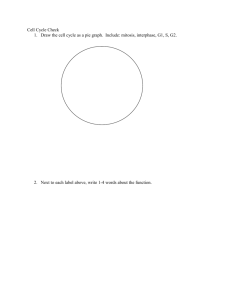1.2 IPP notes
advertisement

Chapter 1 Section 1.2 Definitions: Mitosis Centromere Cell Plate Replication Spindle Fibres Cell Cycle Chromosomes Centriole Understanding the Cell Cycle (Introduction) P. 17 The cell is the basic unit of all living things, as we have seen. It spends most of its lifetime carrying on much the same functions as all living things- growth, respiration, digestion, excretion, absorption, circulation, etc. But, at some point the cell must divide because all living things have a certain limited lifespan. So, if the cell didn’t reproduce, the organism would die as the cells aged and died. Most living things consist of huge numbers (hundreds of millions or trillions) of cells. Yet, even in the case of humans, living things begin life as one cell which splits to form two identical cells. As this process continues over and over, these two cells split further to form four, then eight, sixteen, thirty -two and so on. As you can see on P. 25, the rate of reproduction varies from cell type to cell type. Brain and nerve cells rarely reproduce while the lining of the stomach and intestine last only a few days and so must be replaced rapidly. Thus, in order for an organism to grow and to replace dying and damaged cells, regeneration of cells is necessary. Before a cell can split, the DNA in the nucleus must be reproduced so each cell has a complete set of DNA. Imagine a set of blueprints with half the information missing. The structure built would not be what was intended. In the same way, a cell must have a complete set of DNA in order to function properly. So, the first step in cell division is the reproduction of another complete set of the DNA strands (chromosomes) in the cell. This is what we will look at next. Questions: Introduction & Mitosis (use above note!) P.17 1. The average adult consists of 10 trillion cells. Yet you began life as only one fertilized cell. What happened to produce the trillions? 2. A) Does a cell live forever? B) What, then, must happen if the entire organism is to go on living? 3. A) What vital material does every cell need in order to control its normal functioning? B) This material forms long strands called what? 4. Before mitosis can begin, what must happen to this item mentioned in the previous question? 5. What is the name of the process which provides the cell with these double strands? Mitosis- the stages (pg 18-19) 1. Prophase: - Strands of DNA now visible under microscope. - Nuclear membrane (not cell membrane) disappears. - Centrioles (not visible in first photo but are in the diagrams) move to each end of cell. - Spindle fibres begin to grow outwards form centrioles. 2. Metaphase: - The spindle fibres have stretched from one centriole to the other and have pulled the chromosomes into a line across the middle of the cell. - 3. Anaphase: Spindle fibres shorten or shrink and pull the DNA strands toward the ends of the cell. 4. Telophase: A complete set of chromosomes at each end of cell. Spindle fibres disappearing. Nuclear membrane reforming around each set of DNA. ** Animal cell mitosis sheet attatched** Cell Division(pg22) Plant Cell- A cell plate develops across the center of the cell forming a new cell wall between the two new cells. Animal Cell- the new membrane pinches in new the middle of the cell dividing the cytoplasm into two new cells. After Mitosis is finished, the cell continues to split into two new cells. (MITOSIS IS THE SEPARATING OF THE DUPLICATED DNA AND IS COMPLETED BEFORE THE CELL DIVIDES.) Interphase: - most of a cell’s life is in interphase - “inter” means between - during interphase the cell grows, replicates its DNA and becomes prepared for the first phase of mitosis Mitosis P. 17-19: 1.A) What is meant by the term “replication”? B) When does replication take place in a cell? 2. What happens to this replicated chromatin (now called “chromosomes”) before mitosis occurs? 3. List, in the order in which they occur, the four stages of mitosis. 4. A) What happens to the organelle known as the centriole in the first stage of mitosis (prophase)? B) What happens to the nuclear membrane at the same time? C) What begins to form or grow from each centriole? 5. Describe where the DNA is by the second phase of mitosis (metaphase). 6.A) What happens to these spindle fibres in the third phase of mitosis (anaphase)? B) What does this do to the DNA lined up across the middle of the cell? 7. By the fourth stage (telophase), where is the cell’s DNA? 8. What now reappears around this DNA? 9. After mitosis is complete, there is still just the one original cell. Explain how the next generation of cells appears. Interphase P. 22-23 1. From the discussion on P. 22, what do you think the term “interphase” refers to? 2. What activities does a cell carry on during interphase? 3. What does the term “cell cycle” refer to?








